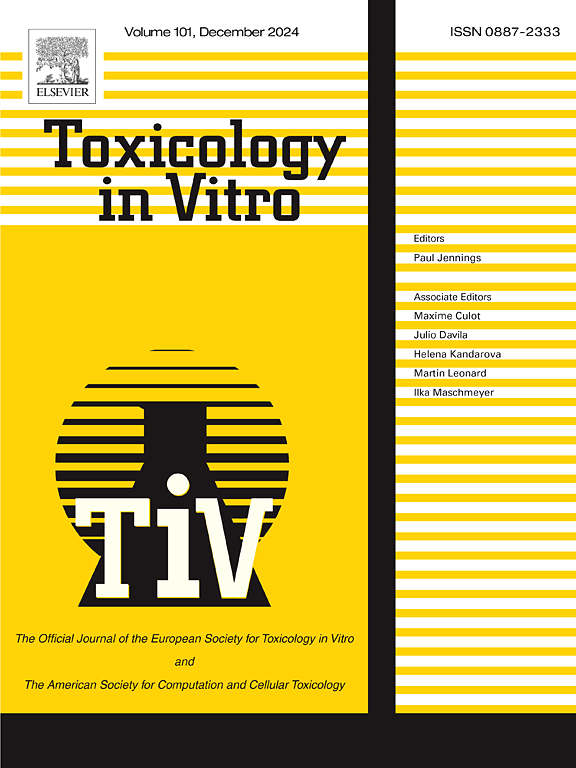环孢素 A 对诱导多能干细胞分化的内皮细胞的毒性:构建不良后果途径
IF 2.6
3区 医学
Q3 TOXICOLOGY
引用次数: 0
摘要
在药理学研究中,环孢素 A(CSA)是一种强效免疫抑制剂。然而,有证据表明它有副作用,特别是在血管功能障碍方面。其诱导内皮细胞毒性的作用模式尚不明确,与不良后果途径(AOP)的联系也尚未确定。因此,我们设计了这项研究,以深入了解 CSA 对血管生成的机理毒性。干细胞,尤其是具有分化为人体所有器官能力的诱导多能干细胞(iPSCs),被认为是减少动物实验的一种有前途的体外模型。在这项研究中,我们将iPSCs分化为内皮细胞(ECs),作为一种细胞类型,在其他研究中可从单一供体生成细胞或器官组织。流式细胞术和免疫染色证实了我们的可扩展分化方案。然后进行了剂量和时间过程实验,评估 CSA 对 iPS 衍生内皮细胞的细胞毒性。转录组数据表明,CDA 依赖性诱导活性氧(ROS)和线粒体功能障碍,体外实验证实了这一点。此外,CSA 通过诱导 ROS 阻碍了血管生成。最后,我们根据观察到的和文献中有关 CSA 介导的内皮细胞毒性的证据,将这些信息整合到一个 AOP 中。该 AOP 将有助于设计体外测试电池、模拟人体毒性研究中观察到的事件以及预测毒理学。本文章由计算机程序翻译,如有差异,请以英文原文为准。
Cyclosporin A toxicity on endothelial cells differentiated from induced pluripotent stem cells: Assembling an adverse outcome pathway
Cyclosporin A (CSA) is a potent immunosuppressive agent in pharmacologic studies. However, there is evidence for side effects, specifically regarding vascular dysfunction. Its mode of action inducing endothelial cell toxicity is partially unclear, and a connection with an adverse outcome pathway (AOP) is not established yet. Therefore, we designed this study to get deeper insights into the mechanistic toxicology of CSA on angiogenesis. Stem cells, especially induced pluripotent stem cells (iPSCs) with the ability of differentiation to all organs of the body, are considered a promising in vitro model to reduce animal experimentation. In this study, we differentiated iPSCs to endothelial cells (ECs) as one cell type that in other studies would allow to generate multi-cell type organoids from single donors. Flow cytometry and immunostaining confirmed our scalable differentiation protocol. Then dose and time course experiments assessing CSA cytotoxicity on iPS derived endothelial cells were performed. Transcriptomic data suggested CSA dependent induction of reactive oxygen species (ROS), mitochondrial dysfunction, and impaired angiogenesis via ROS induction which was confirmed by in vitro experiments. In order to put these data into a potential adverse outcome pathway (AOP) context, we performed a literature review for CSA-mediated endothelial cell toxicity and combined our experimental data with the publicly available knowledge. Such an AOP will help to design in vitro test batteries and to model events observed in human toxicity studies, as well in predictive toxicology.
求助全文
通过发布文献求助,成功后即可免费获取论文全文。
去求助
来源期刊

Toxicology in Vitro
医学-毒理学
CiteScore
6.50
自引率
3.10%
发文量
181
审稿时长
65 days
期刊介绍:
Toxicology in Vitro publishes original research papers and reviews on the application and use of in vitro systems for assessing or predicting the toxic effects of chemicals and elucidating their mechanisms of action. These in vitro techniques include utilizing cell or tissue cultures, isolated cells, tissue slices, subcellular fractions, transgenic cell cultures, and cells from transgenic organisms, as well as in silico modelling. The Journal will focus on investigations that involve the development and validation of new in vitro methods, e.g. for prediction of toxic effects based on traditional and in silico modelling; on the use of methods in high-throughput toxicology and pharmacology; elucidation of mechanisms of toxic action; the application of genomics, transcriptomics and proteomics in toxicology, as well as on comparative studies that characterise the relationship between in vitro and in vivo findings. The Journal strongly encourages the submission of manuscripts that focus on the development of in vitro methods, their practical applications and regulatory use (e.g. in the areas of food components cosmetics, pharmaceuticals, pesticides, and industrial chemicals). Toxicology in Vitro discourages papers that record reporting on toxicological effects from materials, such as plant extracts or herbal medicines, that have not been chemically characterized.
 求助内容:
求助内容: 应助结果提醒方式:
应助结果提醒方式:


